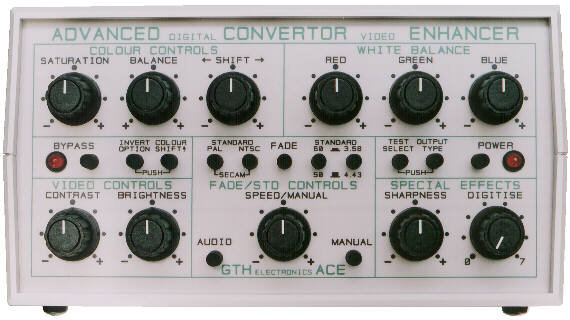

The following descriptions explain the main purpose of each control and there is also a 'Useful Tips' section in the Instruction Manual where some interesting and useful combinations are suggested. Our Example Screens and the IOV FOCUS Review show some of the effects which can be achieved. Please see the Performance and Specifications page for full technical details of performance and connections.
Click on any Control Group in the Picture Above to go Directly to its Description.
| Format | Version | Fields | Colour | STANDARD | STANDARD | ||
| PAL | NTSC | 60 | 3.58 | ||||
| PAL | BDGHIN (UK etc) | 50Hz | 4.43MHz | IN | OUT | OUT | OUT |
| Pseudo PAL | 60Hz | 4.43MHz | IN | OUT | IN | OUT | |
| M | 60Hz | 3.58MHz | IN | OUT | IN | IN | |
| Combination-N | 50Hz | 3.58MHz | IN | OUT | OUT | IN | |
| NTSC | M (USA etc) | 60Hz | 3.58MHz | OUT | IN | IN | IN |
| N | 50Hz | 3.58MHz | OUT | IN | OUT | IN | |
| - | 50Hz | 4.43MHz | OUT | IN | OUT | OUT | |
| - | 60Hz | 4.43MHz | OUT | IN | IN | OUT | |
| SECAM | BDGKL | 50Hz | 4MHz FM | IN | IN | Any Position | |
FADE: This button initiates an Automatic Fade if Manual is Not Selected. Pressing it IN will cause the picture to fade to black. Releasing the button to OUT will cause the picture to be restored by a reverse fade.
AUDIO: With this button pressed IN the Audio can be faded along with the Video fade.
MANUAL: This button selects between the Automatic Fade and the Manual Fade:
SPEED/MANUAL: With the MANUAL button left OUT this control adjusts the speed of the Automatic Fade from approximately 1 to 5 seconds. With the button IN this control allows Manual fading. See Specials Page for other uses of AUDIO and MANUAL buttons and SPEED/MANUAL control.
BALANCE: This control alters the colour balance of coloured areas
without affecting white balance and is especially
useful for correcting any residual faults in skin tone when white
balance has been corrected. This is important as White Balance alone
does NOT cure All colour faults. The ACE is unique in offering both.
NOTE: When the video input source is NTSC this control automatically
acts as a HUE control.
<-SHIFT->: After recording and video processing you will often
find that the colour seems to 'bleed' out of
the coloured areas. This is caused by faults in the video processing which
can move the colour sideways compared to the black and white parts of the
picture and is particularly evident with multiple generation copies. This
control allows the colour part of the picture to be moved horizontally
left and right to line up the colour properly and eliminate the colour
bleed.
Vertical Colour Shift is provided by the COLOUR SHIFT
^ Control to cure colour droop.
DIGITISE: As this control is turned clockwise it gradually decreases the number of colour and brightness levels in the picture, resulting in an increasing paint effect. At its most effective position the brightness levels are only black and white with no shades of grey. Colour levels are similarly restricted. Used at intermediate settings this control can convert a normal picture into something similar to a cartoon with bold colours in blocks. This control also allows you to clean up your own captions and in combination with other controls allows you to add background or foreground colour to simple hand drawn or printed black & white captions. NOTE: This becomes the Zoom / Aspect Ratio Conversion control if these features are enabled. (See Zoom Page)
INVERT OPTION: Pressing this button allows you to cycle through the options in order: Normal / Negative / Colour Invert / Video Invert. In Negative Mode it is possible to view colour negatives, assuming you have a slide converter and film strip holder or can improvise. With Colour Inverted, green turns into purple, blue into yellow and skin tone a ghastly blue colour. Ideal to turn people into monsters! With Video Inverted, black parts of the picture go white and vice-versa. With Normal Colour this can have a quite pleasing but spooky effect. The White Balance and Colour Balance controls provided on the ACE are essential for colour correction of negatives. NOTE: This becomes the Left/Right Mirror Imaging control on the "M" Special Version. (See Special Versions Page)
COLOUR SHIFT ^: Pressing this button allows you to cycle through the Vertical Colour Shift range of 0 to +3 lines and back to 0, to get rid of 'colour droop' often resulting after several generations of copying.
OUTPUT TYPE: Pressing this button allows you to cycle through 4 output combinations on the "S" Video Output & SCART Connectors, allowing access to "S" or Dual Composite Video on the "S" Output Socket and to RGB or YUV on the SCART Socket.
POWER: The operation of this button will come as no surprise. It must be IN for normal operation!
Copyright GTH Electronics 1997 - 2025
Click Here to Return to the
GTH Home Page
| Email to: sales@gthelectronics.com | Telephone: 01692 402501 | International Tel: +44 1692 402501 |